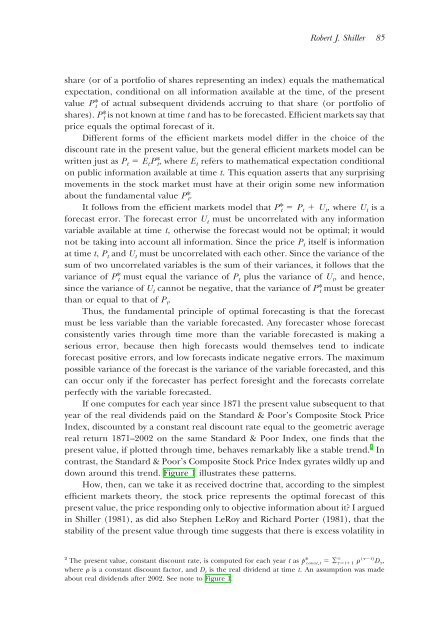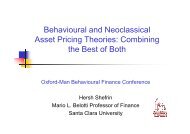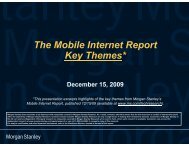From Efficient Markets Theory to Behavioral Finance
From Efficient Markets Theory to Behavioral Finance
From Efficient Markets Theory to Behavioral Finance
You also want an ePaper? Increase the reach of your titles
YUMPU automatically turns print PDFs into web optimized ePapers that Google loves.
Robert J. Shiller 85<br />
share (or of a portfolio of shares representing an index) equals the mathematical<br />
expectation, conditional on all information available at the time, of the present<br />
value P* t of actual subsequent dividends accruing <strong>to</strong> that share (or portfolio of<br />
shares). P* t is not known at time t and has <strong>to</strong> be forecasted. <strong>Efficient</strong> markets say that<br />
price equals the optimal forecast of it.<br />
Different forms of the efficient markets model differ in the choice of the<br />
discount rate in the present value, but the general efficient markets model can be<br />
written just as P t E t P* t , where E t refers <strong>to</strong> mathematical expectation conditional<br />
on public information available at time t. This equation asserts that any surprising<br />
movements in the s<strong>to</strong>ck market must have at their origin some new information<br />
about the fundamental value P* t .<br />
It follows from the efficient markets model that P* t P t U t , where U t is a<br />
forecast error. The forecast error U t must be uncorrelated with any information<br />
variable available at time t, otherwise the forecast would not be optimal; it would<br />
not be taking in<strong>to</strong> account all information. Since the price P t itself is information<br />
at time t, P t and U t must be uncorrelated with each other. Since the variance of the<br />
sum of two uncorrelated variables is the sum of their variances, it follows that the<br />
variance of P* t must equal the variance of P t plus the variance of U t , and hence,<br />
since the variance of U t cannot be negative, that the variance of P* t must be greater<br />
than or equal <strong>to</strong> that of P t .<br />
Thus, the fundamental principle of optimal forecasting is that the forecast<br />
must be less variable than the variable forecasted. Any forecaster whose forecast<br />
consistently varies through time more than the variable forecasted is making a<br />
serious error, because then high forecasts would themselves tend <strong>to</strong> indicate<br />
forecast positive errors, and low forecasts indicate negative errors. The maximum<br />
possible variance of the forecast is the variance of the variable forecasted, and this<br />
can occur only if the forecaster has perfect foresight and the forecasts correlate<br />
perfectly with the variable forecasted.<br />
If one computes for each year since 1871 the present value subsequent <strong>to</strong> that<br />
year of the real dividends paid on the Standard & Poor’s Composite S<strong>to</strong>ck Price<br />
Index, discounted by a constant real discount rate equal <strong>to</strong> the geometric average<br />
real return 1871–2002 on the same Standard & Poor Index, one finds that the<br />
present value, if plotted through time, behaves remarkably like a stable trend. 2 In<br />
contrast, the Standard & Poor’s Composite S<strong>to</strong>ck Price Index gyrates wildly up and<br />
down around this trend. Figure 1 illustrates these patterns.<br />
How, then, can we take it as received doctrine that, according <strong>to</strong> the simplest<br />
efficient markets theory, the s<strong>to</strong>ck price represents the optimal forecast of this<br />
present value, the price responding only <strong>to</strong> objective information about it I argued<br />
in Shiller (1981), as did also Stephen LeRoy and Richard Porter (1981), that the<br />
stability of the present value through time suggests that there is excess volatility in<br />
2 <br />
The present value, constant discount rate, is computed for each year t as p* const,t ¥ t1 (t) D ,<br />
where is a constant discount fac<strong>to</strong>r, and D t is the real dividend at time t. An assumption was made<br />
about real dividends after 2002. See note <strong>to</strong> Figure 1.
















